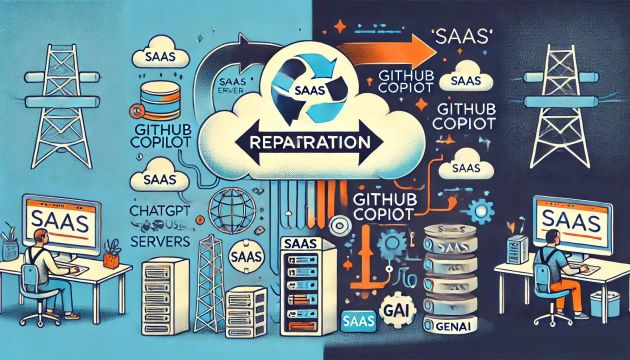In Will ChatGPT Kill SaaS?, I coined the term SaaS Repatriation to describe the nascent practice of enterprises shutting down their SaaS products and developing AI systems inhouse using ChatGPT, GitHub Copilot, and Replit. This is like the good old custom development of software, just built by these three popular AI coding copilots rather than human programmers.
In that post, we did a thought experiment to assess the outlook of SaaS Repatriation.

Since then, there has been a fair amount of public commentaries on the feasibility of SaaS Repatriation, both for and against.
In this post, I’ll share my thoughts on them.
1. For
 GenAI code assistants have become very powerful. You can upload the screenshot of a SaaS software and ChatGPT will give you the code for it. So the traditional BUILD option can work now.
GenAI code assistants have become very powerful. You can upload the screenshot of a SaaS software and ChatGPT will give you the code for it. So the traditional BUILD option can work now.
I can easily get behind this narrative based on my personal experience of getting code that worked right first time for many small applications that I highlighted in Will ChatGPT Kill Coders?.
That said, as I pointed out in Why ChatGPT Won’t Kill Coders, ChatGPT may not make the grade when it comes to large and complex apps.
2. Against
ChenLi W asks on Twitter:
@chenliw: It’s all fine and well to build custom SaaS in-house, but how do you think about business continuity planning?
This is easily addressed. I replied:
@s_ketharaman: The first wave of SaaS companies focused only on replacement of inhouse dev. SaaS companies in Testing, DRS, BCP, Security, etc. came later. No reason why AI software won’t follow the same trajectory / priority.
3. Against
What if Klarna’s customers think of Klarna as a SaaS and do to Klarna what Klarna has done to Salesforce? Krish Dasgupta has an interesting take on this on X:
@officialKrishD: Imagine if Klarna’s own clients say “Hey, we have come up with a plan for our customers. Pay Modes. Based on their credit scores, our PAI (pronounced Pay) Assistant gives four options – Pay Now, Pay Later, Pay in Installments, Pay in Longer Installments. All interest free. Oh, and we’re using AI agents. Thanks for the motivation.”
Payments technology is not all that complex, so it’s not hard to develop BNPL functionality inhouse. In fact, retailers, pharmacies and other businesses in USA, India, and many other countries offered installment purchase of consumer durables and other products as far back as the 1950s. Over time, they found the costs of underwriting, issuance, collections, recovery and other elements of the lending business to be very high. Ergo, they outsourced the whole credit process to credit card and BNPL providers.
In short, companies eschew BNPL not because of complexity of technology but due to high cost of operations. While they can easily develop BNPL functionality inhouse, it doesn’t make any commercial sense for them to enter – actually, re-enter – the BNPL business.
So replacement of Klarna is less likely than replacement of Salesforce / Workday.
4. Against
Some people think Klarna will need to pay Workday for IP if it redevelops similar functionality, which might render the cost of AI BUILD prohibitive.
That’s not true. Not legal advice but royalty is payable only if Klarna uses the Workday code. Since the BNPL major plans to develop fresh code, there’s no question of IP infringement or payment for IP thereof.
5. For
@HarryStebbings: Anyone who thinks large corporates are going to use AI to build their own apps needs to go inside a large corporate. I promise you, we have some room to run on enterprise software.
@santiagotheory: Yes… and people said the same thing about cloud (omg, enterprise will never move off prem)…and then SaaS (omg, enterprise will never pay subscriptions, and what about security!)… it won’t happen at once, but it will happen. Enterprise SaaS margins are way too fat for it not to.
I’m inclined to go with @santiagotheory. As in the case of cloud and SaaS, companies will not jump into SaaS Repatriation headlong. They will wait for the next SAAS to appear on their shopping cart, put the purchase on hold, pilot the AI BUILD option, and take it from there. If the pilot succeeds, they’ll go full steam ahead and extend SaaS Repatriation to other existing apps (as they did while progressively adopting cloud infra). If the results of the pilot are not so encouraging, they might abandon SaaS Repatriation (as it happened in the case of blockchain).
6. For
Ryan Denehy expects SaaS Repatriation to gain traction if their companies pay CIOs a certain percentage of the savings obtained by retiring SaaS.
I agree.
Historically, sales reps of software vendors (and their bosses) have been paid commissions for selling software. However, I don’t know a single company that pays commissions to its CIO for buying software based on the increase in revenue or reduction in cost driven by the software.
It’s an open secret that the average enterprise user uses a maximum 30-40% features of COTS software. But, notwithstanding that, companies have regularly upgraded their software landscape to the next version of every software that vendors have released. According to my conspiracy theory, it’s because, If CIOs underbuy, they face flak from business for not meeting their requirements and from the CFO for asking for money for a Change Request. So they overbought, without worrying too much about whether the full feature of the software was going to be used or not. Crudely put, this is a nod to the famous slogan of National Rifle Association: “It’s better to have a machine gun and not need it than to need a machine gun and not have it”.
In 2012, I predicted that SAAS will cut down on bloatware. My prediction has aged badly: Twelve years later, companies still buy bloated SaaS software.
Bloomberg Terminal. 15000 functions. Of which average customer uses only 29. https://t.co/dTV5quntpI.
Exhibit A: Bloatware works in SAAS, just as it did in Onprem / COTS software. Contradicts my optimistic prediction that SAAS would kill bloatware. https://t.co/KqfXdDyYCe. pic.twitter.com/eJMgpSsDCs— Ketharaman Swaminathan (@s_ketharaman) February 6, 2024
Whether it’s COTS or SAAS, the NRA slogan thinking has held true.
But one thing has changed.
In the past, when enterprises evaluated inhouse development versus COTS / SAAS, the BUILD option almost always had a way longer time to market, which is one big reason why they veered towards the BUY option, even if the product they bought had many features they wouldn’t use.
 AI changes that. Early adopters are reporting that they’re able to develop clones of midsized applications like Trello in 45 minutes. Nothing close to that was possible in the BUILD option before.
AI changes that. Early adopters are reporting that they’re able to develop clones of midsized applications like Trello in 45 minutes. Nothing close to that was possible in the BUILD option before.
A technology is now available that makes the BUILD option practical. Maybe all that’s required is to incent the CIO to opt for it? Just like incentive to sales reps boosts sales, maybe a bonus for CIO based on cost savings will wipe out the NRA slogan from their muscle memory?
Worth trying out, if you ask me.
It’s too early to predict if SaaS Repatriation has legs or will fizzle out.
But, either way, it will have some impact in the immediate term. More on that in a follow-on post.
Watch this space!

